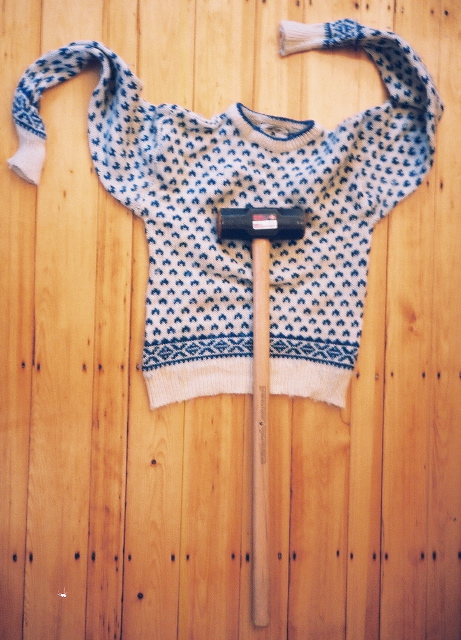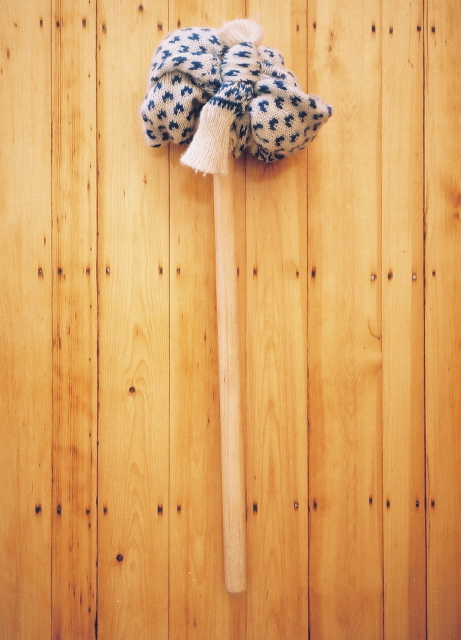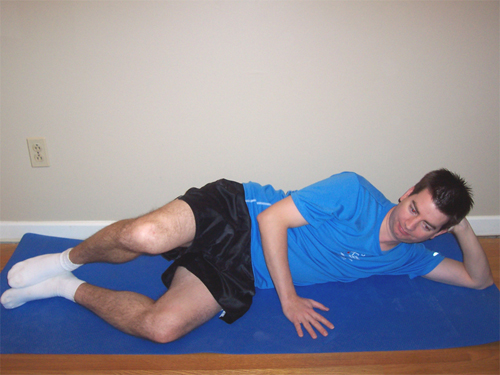Friday, December 31, 2010
Making Plans
Wednesday, December 29, 2010
Shovelglove!
"I wanted an exercise I could do right there, in my bedroom, without any fancy equipment.
But I didn't want to do sit-ups or pushups. I didn't want to grovel on my stomach on the floor, like some degraded beast. "There must be some kind of movement I can do standing up, with the dignity of a human being," I thought, "some kind of movement that is natural and interesting, that my body would like to do."
I started making all kinds of spastic movements, hoping to come across something that resonated. I remembered reading something in some French novel about coal shovelers having the best abdominal muscles of anyone the author had ever seen. I started making shoveling motions.
Now there are a few problems with shoveling, from an exercise perspective. For one, if I actually went outside and started shoveling, I'd get all wet (remember, it's raining). The neighbors would think I was crazy, and if I did it at the wrong time I'd actually annoy them. I'd also have to have something to shovel, a waste of space, at least (our backyard is more of back alley). So outdoors is out. But I couldn't really shovel indoors, either. Even if I just did a pantomime with a shovel, I'd need some kind of weight to move, and I'd need some way of keeping it from scratching the floors or killing the cats."
And out of such turmoil and chaos came the shovelglove. Of course if you want to learn more you'll have to visit the website. (By the way, his website is considerably more enjoyable reading than just about anything else you'll waste 5 minutes on today so it's worth a peek.)


A shovelglove then, is just a sledgehammer with the head wrapped in a sweater or towel so that you don't brain yourself or scratch up the floors. The idea behind it is to mimic movements you might otherwise do in "real life" like shoveling, chopping wood, lifting luggage etc. It's really not unlike the new clubbells that are out and being used by the kettlebell types. By doing swinging motions with a free weight that has a center of gravity away from your body it engages several muscles involved in range of motion and works more than just a single muscle group at a time; the same concept that has made kettlebells so popular and effective.
I have yet to try it. My beautiful wife is a little skeptical that I won't wind up putting a whole in the wall...or ceiling...or my face. However, the idea sounds great and I'm confident that my powers of persuasion will win out sooner or later.
While you may not be signing up for a shovelglove class at the local gym anytime soon this shovelglove fella may just be on to something. He even has his own YouTube Channel.
Monday, December 27, 2010
Another good reason to train your core



Friday, December 24, 2010
Wednesday, December 22, 2010
Simple Garlic Hummus
Monday, December 20, 2010
You need fat too!
You're body is made up of cells. A couple hundred years ago you might have looked at me and just said, "huh?" But thanks to the microscope and some advances in science (as well as public education) I feel pretty confident you can track with me here. Now where were we...ah yes, cells. You're body is made up of cells. Skin cells, stomach cells, hair cells, muscle cells, fat cells and more. Despite the fact that these cells all are part of different organs and systems, they have more in common than you may think. One of the things that all these cells have in common is their outer layer.
Cells have what is called a membrane which is composed of a lipid bilayer. What that basically means is that each cell is encased in a double layer of fat molecules. That's right fat molecules (aka lipids). And an important source for those cell walls is the fat that you eat. The fat you eat and cholesterol that you eat and that your body makes are mostly responsible for making the walls of your cells. The combination of those two components helps to determine how hard or soft those walls are. In the ideal world it would be the perfect combination of not too soft and not too hard, but every person is a little different based on their diet and their genetics.
This is part of the reason that trans fats are such a big deal. Initially when trans fats were invented we thought they were a great cheap solution to always needing plant or animal products, but as we quickly found out it's hard to beat nature at it's own game. By now it is impossible to go into a store without seeing bags of anything and everything labeled "0 Grams of Trans Fat" or "Trans Fat Free." That's because we learned that when trans fat gets included into our cell walls it tends to pack very tightly together. This means rigid cell walls (among other problems). Fats made by people and animals are almost exclusively cis-fats. While trans fats generally make straight linear molecules, cis-fats have some twists and bends in them. They create little extra spaces for molecules to move around and your cell membrane stays "softer" so to speak. Because of all of these problems trans fats are one item I would say are okay to put on the official "bad" list.
Another fat to avoid in excess is saturated fat. Saturated fats have similar properties in your cell to trans fats, but are naturally occuring in animal products and still not as bad as trans fats. This makes intuitive sense because we all are aware that eating a stick of butter or having bacon with every meal (both of which have a large amount of saturated fat) is not a good idea. Saturated fat, though, is not necessarily something to completely eliminate from your diet. For one, it would mean eating almost no animal products which is not a truly healthy or realistic option. In addition, your body can handle saturated fat and deal with it without too much difficulty, but just like any other nutrient if you eat too much of it you will not be happy with the outcome.
Now there are a couple of fats that are good for you. Namely unsaturated fats as well as omega-3 and omega-6 fatty acids. Unsaturated fats are found in nuts, seeds and other plant products and they are generally liquid at room temperature when they are isolated (as compared to saturated fats which are typically solid at room temperature-this is another good indicator of the quality of fat you are eating. Have the solids sparingly and enjoy the liquids). These unsaturated fats are the kinds that will leave your cells' walls soft and happy instead of rigid. Omega-3 and omega-6 fatty acids are important for multiple uses in the body, but they can't be made by humans, so they need to be eaten instead to be included in our bodies.
But now I've been babbling long enough, let's get to the payoff.
If you had to distill all of this information into a quick application it would be this. Don't avoid fat because you think "fat is bad." Fat has twice as many calories/gram as carbohydrate or protein so it's important to eat less of it if you want to avoid packing extra supplies of it on your body. However, it's not necessary to avoid it altogether and isn't good for you to do so either. Try enjoying some almonds instead of potato chips or using olive oil in place of butter. These are good ways to make sure that you get the fat you need without overdosing on the fat you don't need.
I know it's complicated, but you can do it. If you are just tuning in, check out more of this series on the three main nutrients under the Nutrition tags.
Saturday, December 18, 2010
Exercise as an appetizer for breakfast
The first group did no exercise for the six weeks of the experiment and ate 30% more calories than would be appropriate for their need. In the end they gained an average of 6+ pounds (big surprise, huh?). Moreover, they saw in just those six weeks a decrease in insulin sensitivity, which is considered main causal problem in Type 2 diabetes.
The second group ate their excess calories in carbohydrate and ate carbs during exercise. Not terribly dissimilar from what a normal athlete would do other than eating excess calories. The results for this group were kind of boring. They gained a little weight because of the excess calories, but the rest of the findings were just kind of blah.
The third group, though, that exercise before breakfast and didn't eat anything during exercise was really interesting. They found that this group not only didn't gain a significant amount of weight, but the group also had increased insulin sensitivity and increased fatty acid oxidation (they used fat better for fuel). Their conclusion was somewhat novel (and a little cocky): "This study for the first time shows that fasted training is more potent than fed training to facilitate adaptations in muscle and to improve whole-body glucose tolerance and insulin sensitivity during hyper-caloric fat-rich diet."
Really it is a pretty cool thing to find out. Lots of athletes know that when they need to drop a little weight, they do a little extra exercise in the morning before breakfast. Bradley Wiggins for instance talked about this being a normal thing for him when he's getting ready to drop a pound or two in preparation for a big race. This study had subjects doing 60-90 minutes of moderate to vigorous exercise which is no small thing. However, the results are also no small thing. If they really hold true, this could be a nice prophylaxis for the holiday season when we are all a little prone to eating more than normal.
One caveat, don't expect your all time greatest results when you exercise before eating or without eating. You can only last so long without fuel and this method essentially has you running on E. If you decide to try it, start easier and work up to your limit instead of just blowing up on your first try.
Friday, December 17, 2010
Swiss Ball Stunts
Monday, December 13, 2010
Swiss Ball: Not even remotely related to Swiss Cake Rolls.
Wednesday, December 8, 2010
BMI is a baseline measure, but also a helpful one
Interestingly, a BMI that is too low is also bad for you (there is such a thing as being too skinny). But before you go pounding down twinkies to try and protect yourself from a low BMI, consider this. The increased risk to your health begins around a BMI of 18 which would be a 5' 6" tall person who weighed less than 118 lbs or a 6' tall person under 140 lbs.
If you're curious you can go to the NIH's BMI Caculator and see for yourself what your BMI is. If that's not enough for you, the next step to finding out more about what kind of shape you're in would be to find out your body composition or % body fat, but that's a conversation for another time.
Thursday, December 2, 2010
What's the big deal about protein?

"Remember, the healthiest diet is based on fruits, vegetables, whole grains and lean sources of protein — not rigid lists of 'good' and 'bad' foods. "
